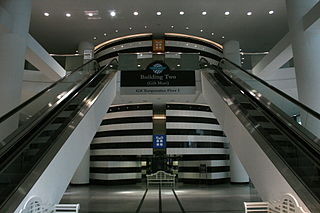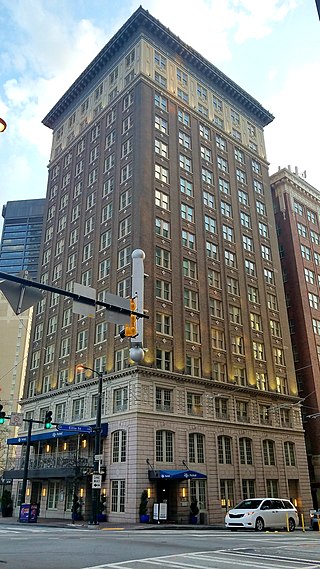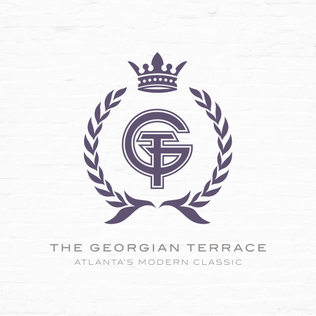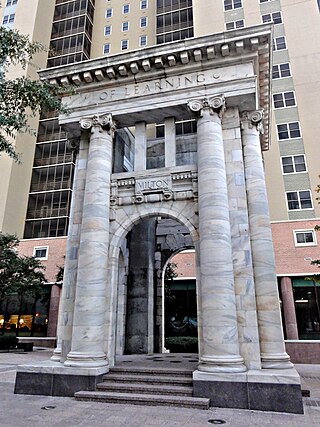
Five Points is a district of Atlanta, Georgia, United States, the primary reference for the downtown area.

The Governor's Mansion is the official home of the governor of the U.S. state of Georgia. The mansion is located at 391 West Paces Ferry Road NW, in the Tuxedo Park neighborhood of the affluent Buckhead district of Atlanta.

The Fairlie–Poplar Historic District is part of the central business district in downtown Atlanta. It is named for the two streets that cross at its center, northeast-only Fairlie and southeast-only Poplar. Fairlie–Poplar is immediately north of Five Points, the definitive center point and longtime commercial heart of Atlanta. It is roughly bounded on the southwest by Marietta Street, on the southeast by Peachtree Street or Park Place, on the northeast by Luckie Street or Williams Street, and on the northwest by Cone Street or Spring Street. It has smaller city blocks than the rest of the city, and the streets run at a 40° diagonal.

1180 Peachtree, commonly known as the Symphony Tower, is a 41-story skyscraper located at 1180 Peachtree Street in the Midtown district of Atlanta, Georgia, United States. Rising to a height of approximately 657 feet (200 m), the building includes office and retail space in its 624,996 sq ft (58,064 m2) of floor area as well as a 1,200 space parking deck. Construction was completed in 2006.

The American Cancer Society Center is a large convention center and office building in downtown Atlanta, adjacent to Centennial Olympic Park. The building contains about 1,500,000 square feet (140,000 m2), including a partially underground parking garage and loading area. The building, originally called the Inforum Technology Center or Inforum, was designed by the prominent Atlanta architect John Portman, who previously designed the AmericasMart buildings.

Peachtree Center is a district located in Downtown Atlanta, Georgia. Most of the structures that make up the district were designed by Atlanta architect John C. Portman Jr. A defining feature of the Peachtree Center is a network of enclosed pedestrian sky bridges suspended above the street-level, which have garnered criticism for discouraging pedestrian street life. The district is served by the Peachtree Center MARTA station, providing access to rapid transit.

AmericasMart Atlanta is a wholesale trade center located in Downtown Atlanta, Georgia. The exhibition center is one of the largest permanent wholesale trade centers in the world. AmericasMart Atlanta consists of three buildings totaling seven million square feet. The Mart opened in 1957, as Atlanta Market Center (AMC), and hosts more than a dozen trade shows every year including The Atlanta International Gift and Home Furnishings Market, Atlanta Apparel and Fall Design Week. Trade show exhibitors rent permanent showrooms as well as temporary booths during trade shows. Some permanent showrooms are open daily, though many are open only part of the time or during trade shows. AmericasMart Atlanta is not open to the public and only employees and guests of registered businesses are admitted.

Atlanta Municipal Auditorium, originally known as the Auditorium and Armory, was an auditorium in Atlanta, Georgia, USA. It was constructed with funds raised by a committee of Atlanta citizens and then sold to the city of Atlanta.

The Ellis Hotel, formerly known as the Winecoff Hotel, is located at 176 Peachtree Street NW, in downtown Atlanta, Georgia, US. Designed by William Lee Stoddart, the 15-story building opened in 1913. It is located next to 200 Peachtree, which was built as the flagship Davison's. It was listed on the National Register of Historic Places on March 31, 2009. The Ellis Hotel is best known for a fire that occurred there on December 7, 1946, in which 119 people died.

The Hotel District is a neighborhood in Downtown Atlanta, Georgia, United States. The district's name is derived from it being the home to many hotels, one of them being the famous Westin Peachtree Plaza Hotel. The Hotel District is generally considered to be bounded by the Downtown Connector to the east, Five Points to the south, Centennial Olympic Park to the west, and Midtown to the north. The district's primary thoroughfare is Peachtree Street, which contains most of the restaurants, hotels, and office buildings. The intersection of Andrew Young International Boulevard and Peachtree Street forms the heart of the district.

South Downtown is a historic neighborhood of Downtown Atlanta, Georgia, United States. South Downtown is primarily home to city, county, state, and federal governmental offices, which prompted the city to adopt signage declaring the area "Government Walk." Although much of South Downtown is dominated by surface parking lots, the neighborhood was passed over during the redevelopment boom of the 1960s and 1970s that resulted in the demolition of much of Downtown's architecturally significant buildings. The result is myriad buildings from the 1950s and earlier that retain their historic structural integrity.

William Lee Stoddart (1868–1940) was an architect who designed urban hotels in the Eastern United States. Although he was born in Tenafly, New Jersey, most of his commissions were in the South. He maintained offices in Atlanta and New York City.

The Medical Arts Building is a Beaux-Arts style building located at the northern end of Downtown Atlanta. The 12-story brick and limestone building by architect G. Lloyd Preacher, also designer of Atlanta City Hall, was constructed in 1927. In addition to its medical facilities - deemed as some of the most modern and well-equipped when it opened, the building once featured a cafeteria, drugstore and telegraph office. It was also amongst the first to have a covered parking garage. However, its nearly 89,000 square feet (8,300 m2) of space have been vacant since 1995.

The Georgian Terrace Hotel in Midtown Atlanta, part of the Fox Theatre Historic District, was designed by architect William Lee Stoddart in a Beaux-Arts style that was intended to evoke the architecture of Paris. Construction commenced on July 21, 1910, and ended on September 8, 1911, and the hotel opened on October 2, 1911. The George C. Fuller Construction Company was contractor, and the developer was Joseph F. Gatins, Jr.

Hotel Row is both a National Register and locally listed historic district consisting of one block of early 20th-century commercial buildings, three to four stories high, located on Mitchell Street west of Forsyth Street in the South Downtown district of Atlanta. The buildings were originally hotels with ground level retail shops built to serve the needs of passengers from Terminal Station, opened in 1905. The buildings are the most intact row of early 20th-century commercial structures in Atlanta's original business district. The decline of Hotel Row began in the 1920s due to the increased availability of automobile transportation and the construction of the Spring Street viaduct, which made getting to hotels in the northern part of the city easier. In the 1950s and 1960s, the increase in air travel led ultimately to the demolition of Terminal Station in 1971.

The Carnegie Education Pavilion, more often known as the Carnegie Monument, is a marble Beaux-Arts monument located in Atlanta, Georgia, United States. The pavilion was constructed in 1996 from the exterior facade of the Carnegie Library, named after Andrew Carnegie. The monument pays homage to the legacy of Carnegie by serving as a monument to higher education in Atlanta, with the seals of nine local area colleges and universities embedded in the floor of the monument. The monument was commissioned in 1996 by the Corporation for Olympic Development in Atlanta and designed by Henri Jova. The pavilion is located in Downtown's Hardy Ivy Park, at the curve in Peachtree Street where it diverges with West Peachtree Street. The monument's inscription reads: "The Advancement of Learning." It also features the inscriptions of the names of three famous Western poets "Dante", "Milton", and "Asop", in addition to the library's namesake, "Carnegie".
The Centennial Park District, formerly the Luckie-Marietta District, is a district of Downtown Atlanta named after the walkable neighborhood and entertainment district that surround Centennial Olympic Park. The district was originally created in 2007 by Legacy Properties, in support of their redevelopment projects in the district. However, "Luckie Marietta" was used by a wide range of Atlanta media to refer to the district. The district was rebranded the Centennial Park District and is now under the management of Central Atlanta Progress.
The Norcross Building occupied the southwest corner of Peachtree Street and Marietta Street at Five Points in downtown Atlanta. Today the Andrew Young School of Policy Studies is located on the site. The building was owned by Jonathan Norcross, "father of Atlanta."

The Hotel Ansley was a hotel that occupied the south side of Williams Street between Forsyth and Fairlie streets in the Fairlie-Poplar district of Downtown Atlanta. It was built in 1913 by Jerome B. Pound of Chattanooga, TN and named for Edwin P. Ansley, developer of the Ansley Park neighborhood; an estimated 5000 guests attended the opening of the $1,000,000 property. The property was originally managed by M.I. and Frank Harrell.

The Hotel Aragon was a six-story, 125-room hotel at 169 Peachtree Street NE, at the southeast corner of Ellis Street in Atlanta, in what is today the Peachtree Center area of downtown. It was a major addition to the city's hotel capacity at its completion in 1892, cost $250,000, and was built and owned by George Washington Collier. It was the only major hotel in the city not adjacent to Union Station. A 1902 guidebook describes the Aragon as one of three first-class hotels in the city, together with the Kimball House and the Majestic Hotel.



















